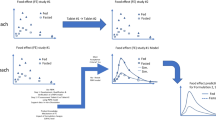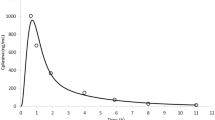Abstract
Investigating the effect of food on bioavailability during the development of an oral drug product is of prime importance because it has major implications on the study design of the clinical trials and dosing and administration recommendations. For modified-release formulations that exhibit dose dumping when administered with food, this may result in clinical concerns around safety and efficacy. In this article, we provide an overview of the various considerations in our opinion that impact the design and conduct of food-effect studies. We summarize the various recommendations from the different regulatory agencies and provide specific suggestions on study conduct in terms of statistical design, timing of studies, subject selection, and type and caloric content of the meal. We also discuss the role of modeling and simulation. Finally, we present an interpretation of the results of food-effect studies in addition to dosing and labeling recommendations in relation to regulatory guidance documents.



Similar content being viewed by others
References
US Department of Health and Human Services, Food and Drug Administration, Center for Drug Evaluation and Research (CDER). Guidance for industry: “food-effect bioavailability and fed bioequivalence studies”. Rockville, MD: U.S. Food and Drug Administration; 2002.
Toothaker RD, Welling PG. The effect of food on drug bioavailability. Annu Rev Pharmacol Toxicol. 1980;20:173–99. https://doi.org/10.1146/annurev.pa.20.040180.001133.
Camilleri M. Integrated upper gastrointestinal response to food intake. Gastroenterology. 2006;131(2):640–58. https://doi.org/10.1053/j.gastro.2006.03.023.
Singh BN. Effects of food on clinical pharmacokinetics. Clin Pharmacokinet. 1999;37(3):213–55. https://doi.org/10.2165/00003088-199937030-00003.
Custodio JM, Wu CY, Benet LZ. Predicting drug disposition, absorption/elimination/transporter interplay and the role of food on drug absorption. Adv Drug Deliv Rev. 2008;60(6):717–33. https://doi.org/10.1016/j.addr.2007.08.043.
Ferrua MJ, Singh RP. Modeling the fluid dynamics in a human stomach to gain insight of food digestion. J Food Sci. 2010;75(7):R151–62. https://doi.org/10.1111/j.1750-3841.2010.01748.x.
Won CS, Oberlies NH, Paine MF. Mechanisms underlying food–drug interactions: inhibition of intestinal metabolism and transport. Pharmacol Ther. 2012;136(2):186–201. https://doi.org/10.1016/j.pharmthera.2012.08.001.
Welling PG. Effects of food on drug absorption. Annu Rev Nutr. 1996;16:383–415. https://doi.org/10.1146/annurev.nu.16.070196.002123.
Lentz KA. Current methods for predicting human food effect. AAPS J. 2008;10(2):282–8. https://doi.org/10.1208/s12248-008-9025-8.
Gu CH, Li H, Levons J, Lentz K, Gandhi RB, Raghavan K, et al. Predicting effect of food on extent of drug absorption based on physicochemical properties. Pharm Res. 2007;24(6):1118–30. https://doi.org/10.1007/s11095-007-9236-1.
US Department of Health and Human Services, Food and Drug Administration, Center for Drug Evaluation and Research (CDER). Waiver of in vivo bioavailability and bioequivalence studies for immediate-release solid oral dosage forms based on a biopharmaceutics classification system guidance for industry. Silver Spring (MD): US Food and Drug Administration; 2015.
Shah VP, Amidon GL, Lennernas H, Shah VP, Crison JR. A theoretical basis for a biopharmaceutic drug classification: the correlation of in vitro drug product dissolution and in vivo bioavailability. Pharm Res. 1995;12:413–20.
European Medicines Agency, Committee for Medicinal Products for Human Use. Guideline on the investigation of drug interactions. London, UK: European Medicines Agency; 2012.
Pharmaceutical and Food Safety Bureau. Guideline for bioequivalence studies of generic products. Japan: Pharmaceutical and Food Safety Bureau; 2012.
Government of India, Central Drugs Standard Control Organization, Directorate General of Health Services, Ministry of Health and Family Welfare. Guidelines for bioavailability and bioequivalence studies. New Delhi, India: Central Drugs Standard Control Organization; 2005.
Standard on pharmaceutical equivalence study. Chungcheongbuk-do, Republic of Korea: Ministry of Food & Drug Safety; 2014.
Health Canada, Minister Health Products and Food Branch. Guidance document: conduct and analysis of comparative bioavailability. Ottawa, Ontario: Minister of Health; 2012.
Australian Government, Therapeutic Goods Administration, Department of Health. Guidance 15: biopharmaceutic studies (previously ARGPM 15: Biopharmaceutic). Wooden, ACT, Australia: Therapeutic Goods Administration; 2015.
Association of Southeast Asian Nations. ASEAN guideline for the conduct of bioequivalence studies. Adopted from: “guideline on the investigation of bioequivalence”. London: European Medicines Agency; CPMP/EWP/QWP/1401/98 Rev 1, 2010; 2015.
Davit B, Braddy AC, Conner DP, Yu LX. International guidelines for bioequivalence of systemically available orally administered generic drug products: a survey of similarities and differences. AAPS J. 2013;15(4):974–90. https://doi.org/10.1208/s12248-013-9499-x.
Marroum P. Bioavailability/bioequivalence considerations for modified release dosage forms, shared concepts and challenges in human and animal health workshop. In: 30th Annual Meeting and Exposition of the Controlled Release Society, July 19–20, 2003.
Meyer RJ, Hussain AS. FDA’s ACPS meeting, October 2005 awareness topic: mitigating the risks of ethanol induced dose dumping from oral sustained/controlled release dosage forms. Office of New Drugs and Office of Pharmaceutical Science Center for Drug Evaluation and Research, FDA; 2005. https://www.fda.gov/ohrms/dockets/ac/05/briefing/2005-4187B1_01_08-Alcohol-Induced.pdf.
Wang R, Conner DP, Li BV. Bioavailability and bioequivalence aspects of oral modified-release drug products. AAPS J. 2017;19(2):360–6. https://doi.org/10.1208/s12248-016-0025-9.
Salem AH, Agarwal SK, Dunbar M, Enschede SL, Humerickhouse RA, Wong SL. Pharmacokinetics of venetoclax, a novel BCL-2 inhibitor, in patients with relapsed or refractory chronic lymphocytic leukemia or non-Hodgkin lymphoma. J Clin Pharmacol. 2017;57(4):484–92. https://doi.org/10.1002/jcph.821.
US Food and Drug Administration. Bioequivalence requirements for highly variable drugs and drug products. Background information for Advisory Committee Meeting on 14 Apr 2004 for ACPS Meeting; p. 10.
Ingersoll KS, Cohen J. The impact of medication regimen factors on adherence to chronic treatment: a review of literature. J Behav Med. 2008;31(3):213–24. https://doi.org/10.1007/s10865-007-9147-y.
Troy SM, Parker VP, Hicks DR, Pollack GM, Chiang ST. Pharmacokinetics and effect of food on the bioavailability of orally administered venlafaxine. J Clin Pharmacol. 1997;37(10):954–61.
US Department of Health and Human Services, Food and Drug Administration, Center for Drug Evaluation and Research (CDER). Guidance for industry: “general clinical pharmacology considerations for pediatric studies for drugs and biological products”. Silver Spring (MD): Clinical Pharmacology; 2014. p. 1–28.
Parrott N, Lukacova V, Fraczkiewicz G, Bolger MB. Predicting pharmacokinetics of drugs using physiologically based modeling: application to food effects. AAPS J. 2009;11(1):45–53. https://doi.org/10.1208/s12248-008-9079-7.
AAPS, Food and Drug Administration, American College of Clinical Pharmacology, American Society for Clinical Pharmacology and Therapeutics. Evaluating and modernizing our approaches for food-effect assessment. Renaissance Baltimore Harborplace Hotel; 2015; Baltimore (MD).
Acknowledgements
The authors thank project manager Mary Knudson, PharmD of AbbVie for project management support and Mia DeFino, MS, a freelance medical writer under contract with AbbVie for medical writing support.
Funding
No funding was received for the preparation of this article.
Author information
Authors and Affiliations
Corresponding author
Ethics declarations
Conflict of interest
Patrick J. Marroum, Silpa Nuthalapati, Apurvasena Parikh, Mohamad Shebley, David Hoffman, Jiuhong Zha, Amit Khatri, and Walid M. Awni are employees of AbbVie and may hold AbbVie stock or stock options.
Rights and permissions
About this article
Cite this article
Marroum, P.J., Nuthalapati, S., Parikh, A. et al. Industry Perspective on Standardizing Food-Effect Studies for New Drug Development. Clin Pharmacokinet 57, 901–909 (2018). https://doi.org/10.1007/s40262-018-0630-0
Published:
Issue Date:
DOI: https://doi.org/10.1007/s40262-018-0630-0




